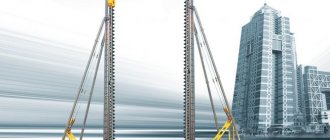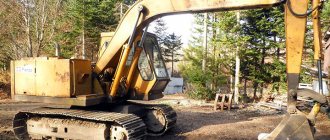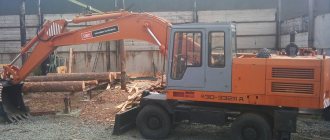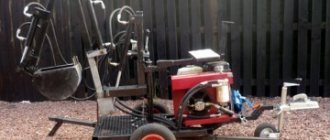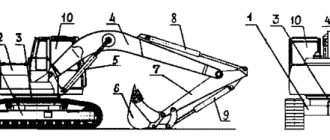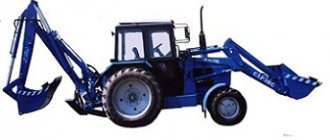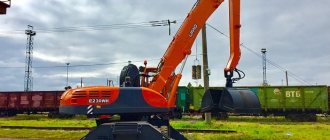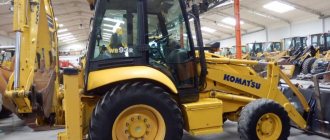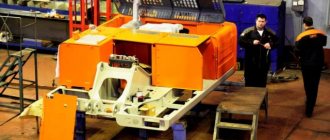The hydraulic excavator is designed to perform excavation and loading operations. This self-propelled vehicle is equipped with a tracked or wheeled undercarriage, on which a rotating platform with an operator’s cabin, engine and attachments is installed. A composite boom with a bucket, driven by a hydraulic system, is mounted as a working body. Special equipment of this type belongs to the cyclic category and performs the following sequence of operations:
- digging (cutting) soil with the latter filling the bucket cavity;
- movement and unloading of the working body;
- returning the bucket to the digging site.
The duration of the operating cycle ranges from 10 to 90 seconds and is determined by external conditions, as well as the parameters of a particular model.
Design
Both mini- and mining hydraulic excavators are single-bucket cyclic machines. In accordance with the generally accepted classification, special equipment of this type is characterized by the presence of:
- track propulsion or wheelbase;
- diesel engine, which drives all working mechanisms;
- hydraulic systems with a main pump with variable capacity and an electronic unit that controls its operation;
- a straight or backhoe, which has a rigid hinge connection with the boom.
Quarry excavators can be equipped with buckets for different types of soil, including special ones designed for working with high-density materials. Such equipment is characterized by resistance to wear and is usually supplied in addition to ordering special equipment.
Repeating the cycle.
The main time of the working cycle (up to 70%) is taken up by the turning time (there and back), which must be taken into account when calculating the productivity of the unit. The most used working part of an excavator is a bucket-straight shovel with a volume of 0.15 to 2.5 m3, the top of which is open and the leading edge is cutting. Using a lever system, the bucket can be rotated in a vertical plane, which ensures its loading and unloading.
The backhoe is used for digging trenches and pits up to 6 meters deep. All modern excavators are equipped with a hydraulic control system for working bodies and a hydraulic drive, which ensures that the unit operates with maximum effort with minimal dimensions of their drives. How does a single-bucket excavator work? (see picture)
The main components of a modern excavator are: the undercarriage, the unit platform, the platform rotation mechanism, the power plant—the engine, the control cabin, the boom, the handle, the bucket, the hydraulic cylinders—the bucket, the booms, and the handles.
The undercarriage is a welded support frame equipped with a caterpillar undercarriage. The tracks are of increased width, rest on rollers mounted on the frame, the front sprockets are tensioned, the rear sprockets are driven. The movement is driven by hydraulic motors, which receive operating oil pressure from a common hydraulic system.
On the upper part of the support frame of the undercarriage, there is a rotating shoulder strap that supports the rotating platform and, with the help of a hydraulic motor and gear transmission, ensures its rotation by 360°.
The control cabin, installed on a rotating platform, contains controls for the working bodies and the movement of the excavator, which are hydraulic distributors, control devices and a convenient place for the driver-operator. The boom, the main load-bearing working body, is a welded beam, hinged at the rear on a rotating platform. On the front part of the boom there is a hinged handle—a double-armed lever, pivotally connected to a bucket, which is a removable working body.
The boom handle and bucket are driven by paired double-acting hydraulic cylinders. A power unit is installed on the turntable - a diesel engine, from which the hydraulic system pumps receive torque. Working bodies control system.
The excavator control system is a complex of units that contains:
hydraulic tank with pumps, manually operated hydraulic distributors, rigid pipes and high pressure hoses.
What are the benefits of a hydraulic drive?
- Simplification of transmission kinematics and working equipment.
- Reducing the size and weight of the machine while maintaining power.
- Expansion of the range of compatible replacement equipment.
- Maximum use of power plant power.
- Rational combination of work operations.
- Smooth movements, precise orientation of the working body.
- Increasing the versatility and mobility of excavators, improving the quality of work, and the ability to perform operations in hard-to-reach places.
- Increased machine productivity by 30–35%.
- Increase in digging effort by an average of 1.5–2 times.
- Stepless speed control.
- Availability of spare parts, possibility of modernization of equipment.
- Improving working conditions for the driver.
Hydraulic machines are more mobile and technologically flexible than mechanical ones. Excavators have a reduced weight, so they can work with both a forward and a backhoe. Hydraulic models are preferred for operations in difficult mining and geological conditions.
Reviews about the company Arden
Good afternoon We would like to express our gratitude to the managers and all employees for their coordinated work. We purchased crushers for concrete and reinforced concrete about six months ago. In addition to affordable prices, I would like to separately note the high quality of the equipment, and also say a big thank you for the competent advice from the manager. There are no difficulties with the purchased products, given their regular use.
This was our first time contacting Arden Equipment. We ordered grabs for scrap metal. We are satisfied with the purchased equipment. We mastered it quickly, thanks to detailed instructions given by the support manager. The quality of the units is high. I would like to thank the company’s employees for their friendly, responsive and competent service! It's a pleasure to work with you! Continue in the same spirit!
We are satisfied with our cooperation with Arden Equipment Vostok, without any complaints. We have been purchasing equipment for construction equipment and consulting with service department specialists for several years now. The manager always responds quickly and helps resolve the delivery issue. The quality of the equipment is more than acceptable and meets all requirements. The pricing policy is flexible. The conditions are always attractive and the most important thing is that the quality of the products does not suffer from this! Thank you!
Arden Equipment for us is reliable attachments for construction equipment! At one time we worked with different manufacturers, but only here we found the optimal combination of price, quality and, moreover, customer focus! Always friendly employees, willingness to quickly provide complete information, discounts for regular customers. Thank you for your decent attitude to work and effective partnership! Success!
Types of replaceable working bodies for hydraulic excavators
- Backhoes of various capacities for digging holes below the parking level of the machine, unloading soil, and cleaning the base of the face. Rotation of the bucket relative to the handle allows you to work in cramped conditions, in close proximity to utility lines.
- Straight shovels with a rotating bucket for developing soils both above and below the parking level, for loading activities. The equipment allows you to plan and clear the base in the face.
- Special buckets for digging narrow trenches and drainage work.
- Double-jaw grabs for digging pits, wells and trenches, for loading stones and large pieces of materials, digging deep holes, including in cramped conditions. The equipment is attached instead of a bucket to the handle of a backhoe. Longitudinal and transverse rocking of the grab is possible. To dig wells up to 30 m deep, the equipment uses intermediate extension inserts.
- Buckets with continuous cutting edge and teeth. Used for cleaning and leveling work.
- Loading buckets of increased capacity for delivering small-sized and bulk materials to a level located above the machine parking lot, for developing and loading soil into vehicles or dumping it into a dump.
- Bulldozer blades. Used for filling trenches, holes, small pits.
- Special grips for logs and pipes.
- Crane suspension for installation and lifting work.
- Single-shank and multi-shank rippers for working with dense, frozen soils, for breaking up asphalt pavements.
- Hydraulic, pneumatic, hydropneumatic hammers with replaceable working bodies for the destruction of rocky soils, brickwork, reinforced concrete, road surfaces, foundations, soil compaction, crushing oversized pieces of rock, driving sheet piles and piles.
Such an excavator successfully removes pits, wells, and also reloads long piece cargo (for example, logs).
There are also economic advantages to hydraulically driven excavators. Thus, the expansion of the range of replaceable working equipment and their specific kinematics, as well as independent regulation of the speeds of combined working movements, make it possible to mechanize those works that were previously performed manually.
The unification of hydraulic drive elements creates real opportunities for organizing the production of hydraulic excavators and producing the required standard sizes of excavators. The range of spare parts for operating excavators is significantly reduced and the possibility of using an aggregate method for their repair is created, and consequently, their downtime is reduced and their useful life is increased. Due to automation of control, the productivity of excavators increases, and due to the automation of their drive, energy resources are saved and the efficiency of machines increases.
Reducing machine maintenance time allows you to reduce the number of maintenance personnel.
The main technical characteristics of hydraulic excavators are given in table. 1.
Below we will look at examples of the most commonly used single-bucket hydraulic excavators.
Partial rotation excavator EO-2621V-3. This excavator, belonging to the 2nd size group, is designed for mechanization of small-scale excavation and loading work. It is mounted on a pneumatic wheeled tractor YuMZ-6KL. This machine is designed for developing soils of groups I...IV and loading bulk and finely crushed materials. The machine is equipped with two types of working equipment: excavator and bulldozer. In total, the machine can be equipped with 22 types of replaceable working equipment and working parts.
The main working part of excavator equipment is a 0.25 m3 bucket of a forward and backhoe. In addition, the excavator can be equipped with a 0.5 m loading bucket, crane suspension, forks, telescopic handle, grab, backhoe with mixed digging axis, hydraulic hammer, ripper tooth, gripper, drilling equipment, profile and special buckets.
Table 1 Technical characteristics of single-bucket hydraulic excavators
Using a backhoe, small pits, holes with steep walls, trenches for underground utilities, and shallow channels are removed. Reclamation canals are cleaned with a profile bucket.
Using a straight shovel, they excavate shallow faces located above the machine parking level, carry out cleaning work in pits, and load bulk and small-sized materials.
Large lump materials are loaded with a lattice bucket.
Using a grab bucket, wells are dug out, trenches and channels are cleared, and various materials and rocks are loaded.
The loading bucket is used for light cleaning work and loading of debris, snow and other materials.
The crane suspension is used for loading and unloading piece goods, laying pipelines and installing poles.
Forks are used when loading.
Bulldozer equipment is installed in the front of the tractor, which is used for filling trenches, clearing roads, and raking construction waste. It can be used to work with soils up to group II inclusive.
A hydraulic hammer and ripper tooth are used to open up the asphalt surface. In addition, the ripper tooth can be used to break up a crust of frozen soil up to 300 mm thick.
Rice. 2. Excavator EO-2621V-3: 1 - fuel tank; 2 — working fluid tank; 3 — driver’s cabin; 4 — control lever; 5—hydraulic distributor; 6 — boom hydraulic cylinder; 7 — hydraulic cylinder of the handle; 8 - boom; 9 — handle; 10 — bucket hydraulic cylinder; 11 - ladle; 12 — lever; 13 — outrigger; 14 — support hydraulic cylinder; 15 — rotary column; 16 - pumping unit; 17, 18 — frames; 19 — hydraulic cylinder of the bulldozer blade; 20 — blade frame; 21 — bulldozer blade
A hydraulic hammer is also used to open concrete coatings and crush rubble stones and frozen soil. A hydraulic hammer equipped with a tamping plate is used to compact bulk soils.
A backhoe with an offset digging axis is used to dig trenches near buildings and structures. Narrow trenches for laying cables are torn off with a special bucket. Using a grabber, logs and other piece materials are loaded. Drilling equipment is used to dig holes of various diameters to a depth of up to 2 m.
Unlike previous models, the EO-2621V-3 excavator is equipped with a new unified bucket of 0.25 m3 of forward and reverse shovels, which has a more rational design. This bucket is of a more rigid design; its bottom does not open; durability is significantly increased. The rotation angle of the bucket is increased due to the use of a six-link mechanism.
To improve the operating parameters of the machine, especially with the main equipment “backhoe”, an elongated handle was used, which made it possible to increase such an important indicator as the digging depth from 3.5 to 4.15 m.
In order to increase the service life of the working equipment, an unloading valve is installed on the bucket hydraulic cylinder.
The stability of the excavator during operation has increased due to the introduction of hydraulic locks into the design of the hydraulic cylinders of the outriggers and the bulldozer blade.
To ensure reliable operation, the metal structure of the bulldozer equipment has been strengthened.
The working equipment is mounted on frames, the fastening of which is made in such a way as to relieve the load on the tractor frame. The bulldozer blade can be installed at different heights using a hydraulic cylinder. In addition to its main purpose, the blade also serves as a counterweight. To increase the stability of the excavator during operation, outriggers are attached to the frame. With the help of two hydraulic cylinders, the supports are lowered to the ground or raised up while the machine is moving.
A rotating column and a rotation mechanism for excavation working equipment, consisting of a boom, a handle and a bucket, are also mounted on the frame. Each of these assembly units is controlled by one (boom and bucket) or two hydraulic cylinders (arm). Liquid is supplied to these hydraulic cylinders under pressure from a pumping unit. The supply of working fluid for the hydraulic system is in the tank.
The machine is controlled by moving the hydraulic valve spools. The driver's seat can be rotated 180°. In one position, the driver controls the tractor while moving, and in the other, the operation of the excavator. For ease of maintenance, the fuel tank is located in the front part of the tractor.
The operator replaces the working equipment within an hour using a crane with a lifting capacity of up to 0.25 tons. In the absence of lifting equipment, the participation of a second worker is necessary for reinstallation.
The drive system completely determines the performance of the machine, the quality of excavation work, the rational combination of work operations, and the maximum use of the power of the power plant.
On domestic excavators, the most common is a dual-flow drive system, in which working fluid from two or three pumps (pump sections) is supplied to two pressure lines. Excavators have two hydraulic systems with one common tank.
The working equipment is installed on the rotating column body. The bucket is mounted on an axle and connected to a hydraulic cylinder through rods. Buckets and a ripper tooth are also mounted on the handle. When installing a fork, the forks are fixedly mounted on the handle with bolts, and the fork is mounted pivotally on the axis of the handle.
When converting to a straight shovel, the bucket is positioned with its teeth facing outward and secured to the lower fork of the handle with rods. The hydraulic cylinder rods are secured in the lower hole of the handle. Buckets are mounted in the same way.
Before installing the grab, disconnect the bucket hydraulic cylinder sleeves, hydraulic cylinder rods and the handle itself. Remove the handle along with the bucket and hydraulic cylinder of the bucket. The grab handle is connected to the boom with a finger. The handle cylinder rods are secured to the handle eye. The head is attached to the handle with a finger.
Two jaws are installed on the head, moving by two hydraulic cylinders. The working fluid is supplied through pipelines and hoses. Instead of a grab bucket with teeth, you can mount grab forks or a bucket without teeth on the handle.
After each replacement, check the operation of the equipment at idle for 5 minutes.
Full-rotary excavators of the 3rd size group are mostly produced on pneumatic wheels.
The main working equipment for such excavators - a backhoe - depending on the category of soil being developed, can be equipped with replaceable buckets. When equipped with a backhoe, excavators are used to dig ditches, trenches and holes. The rotating bucket provides good conditions for digging soil and unloading it into a dump and vehicles. In addition to a backhoe, excavators are equipped with a loader, a grab, a straight shovel and buckets of various shapes for special excavation work.
Rice. 2 a - backhoe; b - straight shovel; c - grab; 1 — bucket hydraulic cylinder; 2 - thrust; 3 - axis; 4 - unified backhoe and forward shovel bucket; 5 - narrow bucket; 6 - profile bucket; 7 - special bucket; 8 — ripper tooth; 9, 10 — bolts; 11 — fork; 12 — hydraulic cylinder of the handle; 13 — loading bucket; 14 — lattice ladle; 75 - grain bucket; 16. 21 - fingers; 17—handle; 18 - pipeline; 19, 20—sleeves; 22 — grab head; 23 — hydraulic cylinder of the grab bucket; 24 — grab bucket jaw; 25 — grab forks; 26 - bucket without teeth
For full-rotary excavators, the most common is a double-flow drive system with variable feed pumps. For excavators of the 3rd and 4th size groups, it is advisable to use twin axial piston pumps with a summing power regulator. Such pumps are produced in a single unit with a transfer gearbox to drive the pumps.
The use of adjustable feed pumps compared to constant feed pumps makes it possible to reduce the power to drive the pumping unit, as well as reduce energy losses for throttling and heating the working fluid.
The universal single-bucket excavator EO-3323 is designed for developing pits, trenches, quarries in soils of groups I ... IV, loading and unloading bulk materials, loosened rocks of frozen soils (piece size no more than 200 mm), as well as other work.
Working equipment of the backhoe: monoblock boom, main and extended handles and replaceable working parts. The latter include: a 0.5 m shovel for working with the main and extended handles (develops soils of groups I...IV), a 0.63 m bucket (soils of groups 1...IV) and a 0.8 m bucket (soils of groups 1...IV) for working with the main handle.
Working equipment of a straight shovel: boom, handle and replaceable working parts - a bucket of 0.63 m' (soils of groups I...IV) and a loading bucket of 1.2 m (materials with a density of up to 1.4 t/m').
The working equipment of the hydrohammer consists of elements of the backhoe equipment (monoblock boom and handle), onto which a working element with replaceable tips (for loosening frozen soils, crushing stones and breaking up road surfaces) or tamping plates (for compacting soils) is hung.
Rice. 3. Hydraulic pneumatic wheeled excavator of the 3rd size group EO-3323 with backhoe equipment
The power plant used is the D-240 diesel engine with direct electric start (or D-240L with electric start of the starting engine) and a pump connected by a friction clutch. The clutch allows you to start the engine when the pump is turned off.
Compared to previously produced excavators of the EO-3322 type, the EO-3323 excavator has significantly increased productivity due to an increase in the capacity of the buckets and an increase in the forces on their cutting edge. The maximum pressure in the hydraulic system has been increased to 25 MPa versus 17.5 MPa for previous machines.
The all-metal sound-heat-insulated cabin of the EO-3323 excavator is equipped with a heater, rear-view mirror, windshield wiper, sun visor, fire extinguisher, first aid kit, and thermos. The driver's seat is sprung and its position is adjustable. The cabin contains a servo control panel for the main mechanisms of the excavator.
The components of the excavator, located on the turntable, are covered with a hood consisting of removable blocks with hinged doors and panels to facilitate access to the systems and mechanisms of the excavator during maintenance and routine repairs.
Crawler excavators of the 3rd size group. This group includes the EO-3122 excavators on a normal tractor-type chassis and the EO-3221 on a widened-extended chassis, which are unified with the EO-3323 pneumatic wheeled excavator.
The EO-3122 excavator has a rotating part that is completely unified with the EO-3323 excavator, with the exception of the steering device, which is not required on crawler excavators.
Rice. 4. Hydraulic crawler excavators of the 3rd size group EO-3122 (o) and EO-3221 (b) with backhoe equipment: 1 - undercarriage; 2 - rotating platform; 3 — hood; 4 — power plant; 5 — cabin; 6 - boom; 7,9, 11 — hydraulic cylinders of the handle, bucket and boom; 8 — handle; 10 - bucket
Shoes with a width of 500 or 600 mm can be installed on the crawler belts of the EO-3122 excavator for working on soils with high and medium bearing capacity.
To expand the scope of application on the machine, the following types of replaceable working equipment and working parts were used: a backhoe, including a monoblock boom 4.55 m long, a standard and extended handle 1.9 or 2.5 m long, respectively; a straight shovel containing an arrow 3.4 m long and a handle 2.3 m long; grab and drilling equipment: hydraulic hammer: replaceable backhoe buckets - 0.4: 0.5; 0.63 p 0.8 m; straight shovel - 0.63 and 1.2 m': profile bucket 0.63 m with a slope of 1:10; grab buckets - 0.32; 0.5; 0.63 and 1.2 m
The hydraulic drive of the EO-3122 excavator is similar to the EO-3323 excavator, i.e. the hydraulic systems of these machines are almost the same.
Due to the equipment with a tracked undercarriage, the EO-3221 excavator is capable of performing a variety of excavation and loading and unloading operations.
Shoes of various widths can be installed on the crawler belts of the EO-3221 excavator for working on soils with high and low load-bearing capacity.
The expansion of the scope of application of the machine is facilitated by the use of the following replaceable parts and working equipment: a backhoe with a boom 4.625 m long and handles 1.9 m long; 3 and 5 m: backhoe with a 6 m long boom and 3 and 5 m long handles; grab equipment; replaceable backhoe buckets - 0.25: 0.4; 0.5: 0.63 and 0.8 m; profile buckets - 0.63 m with slopes 1:1 and 1:1.5: reclamation backhoe - with buckets 0.63, 0.5 (width 1.4, 2 and 2.5 m), 0.4 m (width 1.4 and 2.5 m). 0.1 m (for repairing narrow channels); grab bucket 0.5 m.
Backhoe equipment is important for reclamation work and replaces dragline equipment. This excavator with reclamation equipment can develop or clean canals of six profiles when installing the machine on one side of the canal, while the EO-3211 E cable excavator equipped with a dragline can develop such structures only when working on both sides.
The hydraulic drive of the EO-3221 excavator is similar to the drive of the EO-3122 excavator.
The EO-3221 excavator provides the ability to install the boom in a floating position, which allows you to combine turning the handle in both directions with any other working movement.
To reduce the effort on the control handles in the hydraulic drive of the excavator, a servo control system for hydraulic valve spools is used. A distinctive feature of the EO-3221 excavator compared to the EO-3323 and EO-3122 excavators is the transverse arrangement of the diesel engine with a clutch and pump unit. The rational arrangement of other mechanisms and systems made it possible to save about 1 ton of metal per machine.
The rotary platform of a welded structure is connected to the running frame through a slewing bearing. The working equipment is attached to rack-brackets located in the middle of the front part of the turntable.
The working bodies listed above are designed to work in various ground conditions. Most backhoe buckets can be used to develop soils of groups 1...IV, and with a loading bucket - soils of groups I. II.
Reclamation buckets and a bucket for leveling work can be used to develop soils of groups I and II. A variety of combinations of booms and arms, complete with buckets of appropriate capacity, allows you to make maximum use of the machine’s energy capabilities.
The running gear of the excavator is a caterpillar type with cam engagement of the caterpillar tracks with the drive wheels. The caterpillar tracks are driven by two separate mechanisms, including hydraulic motors and final drives with bevel, spur and planetary gears.
Rice. 5. Backhoe buckets of hydraulic excavators of the 3rd size group: a, b, c—various capacities for heavy, medium and light working conditions; g - for planning work; d - loading; e - for reclamation work; g - profile
The EO-3221 excavator uses caterpillar tracks that are significantly different from the caterpillar tracks of the EO-3122 excavator. The main difference is the ability to use belts of three modifications, which can be quickly interchanged to expand the range of applications of the machines in different soil conditions. The first modification consists of welded-cast shoes 840 mm wide with grousers. The tape includes 42 shoes connected by pins, which are secured with cotter pins to prevent them from falling out. The shoes consist of a cast base and welded elements. Soil sealants of the same modification are used. The second modification is made of welded-cast shoes 1000 mm wide without lugs, and the third has solid shoes 500 mm wide.
Pneumatic wheeled full-rotary excavators of the 4th size group. The EO-4321 B excavator is a modernized model of a pneumatic wheeled excavator of the 4th size group with a hydraulic drive - designed for the development of soils of groups I...IV. For rocks and frozen soils, an excavator can be used provided that the rocks and soils are first crushed into pieces no larger than 400 mm.
The main working equipment is a backhoe with a 0.8 m bucket. Replaceable working equipment and replaceable working parts: a straight shovel with a 1 m bucket. an extended handle of a backhoe with a 0.5 m bucket. a grab with a 0.63 m bucket. Backhoe buckets 0.8 ; 1 and 1.25 m hydraulic hammer for the development of frozen soil, ripper tooth, crane suspension, grab insert for deep digging, gripping jaws, 0.63 and 1 m-1 buckets for reclamation work, loading bucket 1.6 m, etc. .
The EO-4322 excavator can develop non-frozen soils, destroy asphalt concrete pavements, loosen frozen soils, load bulk materials and pre-loosened rocks into vehicles, as well as perform leveling and other work.
Rice. 6. Hydraulic pneumatic wheeled excavator of the 4th size group EO-4321B with backhoe equipment
The main advantage of the hydraulic system of the EO-4322 excavator compared to the hydraulic system of the EO-4321B excavator: the summation of the flow of working fluid from both sections of the pump behind the hydraulic valves using new assembly units (two additional single-spool hydraulic valves, make-up valves, inlet-type hydraulic locks, a central manifold ).
Working conditions for the excavator operator have been improved by reducing the maximum noise level by installing additional insulation in the cab, as well as by more optimally positioning the controls and installing a tilting steering column. In addition, the car uses a new efficient and safe heater using the heat of diesel coolant and a more convenient window lift. At the same time, engine starting conditions at low temperatures have been significantly improved by installing a clutch between the pump and the diesel engine. This excavator has a more rational design of the running and rotating frames, as well as outriggers, which increased the support contour and also reduced the size in the transport position. The bucket capacity of the EO-4322 excavator increased by 20-25%, the digging depth of the backhoe increased by 7-15%, and specific fuel consumption decreased by 7%. Backhoe productivity increased by 17%.
In addition to forward and reverse shovels, the EO-4322 excavator has the following types of working equipment: a grab with a 0.63 m3 bucket; hydraulic hammer; ripper tooth; hook suspension; mounted drilling equipment; narrow buckets (0.5 m3) and cleaning buckets (1 m3), as well as two profile buckets (0.63 m3 each). Crawler full-rotary excavators of the 4th size group. The EO-4124A excavator is designed for the development of group I…IV pounds, as well as loosened rocky and frozen soils.
More than 25 types of replaceable working equipment and working parts have been created for it, including: - backhoe with buckets: 0.65 m3 - for developing heavy soils and working at a digging depth of up to 7.1 m3; 1 m3 - for the development of soils of groups 1...IV; 1.25 m3 - for the development of soils of groups I and II; - straight shovel with buckets: 1 m3 - for developing soils of groups I...IV and loading loosened rocky and frozen soils; 1.5 m3 - for developing soils of groups I and II and loading soils of groups I...IV; 2 m3 - for loading soils of groups I....IV; a loader with buckets of 1 and 1.6 m3 for loading soils and materials with a density of up to 2.2 and 1.6 t/m3; — a grab for digging out wells, trenches and pits in soils of groups I…IV. On his buckets 0.5; 0.8 and 1 m3 installation of replaceable jaws is provided. To increase the digging depth to 10.4 m, the grab is equipped with an extension; — buckets: profile (up to 0.8 m3), stripping (1 m3), for reclamation work and digging narrow trenches (0.3 m3); single-tooth ripper for breaking up frozen soil crust when freezing up to 0.7 m; hydraulic hammer with a tip for loosening frozen and rocky soils (up to 1.5 m deep), breaking up road surfaces, crushing oversized stones; — a gripping and pincer working body with a ripper, which crushes and loads frozen soils and asphalt concrete pavements, removes and lays concrete slabs, dismantles old buildings, etc. The turntable with mechanisms and working equipment rests on the frame of the undercarriage through a roller slewing bearing device. It is equipped with a power plant, hydraulic equipment and control system, a turning mechanism, a fuel tank, a driver's cabin and a counterweight.
The cabin is equipped with ventilation, heat and sound insulation, a soft seat, instrumentation and control levers. Lighting, alarm and cleaning of cabin windows are provided.
The EO-4125 excavator belongs to the second generation of excavators and will eventually replace the EO-4124A excavator.
Rice. 7. Hydraulic crawler excavator of the 4th size group EO-4125 with backhoe equipment
In terms of purpose and design, both of these machines are identical. They can work with the following types of replaceable working equipment: - backhoe with buckets: 0.8 m-1 - for the development of heavy soils of groups V and VI; 1 m3 - for the development of soils of groups I...IV with a digging depth of up to 7.3 m; 1.25 m - for developing soils of groups I and III; straight shovel with buckets: I m3 - for developing soils of groups I...IV and loading rocky and frozen soils; 1.2 m3 - for developing soils of group 1 III and loading bulk soils; — loader with buckets: 1.6 m3 — for loading bulk soils of groups I...IV and developing soils of groups I and II; 1.45 m3 - for loading bulk soils of groups I...IV; 1 m3 - for developing soils of groups 1...IV: - grab for digging wells, trenches and pits in soils of groups I...IV (with a 0.6 m3 bucket) and in soils of groups 1 and 2 (with a 0.75 m3 bucket). Grab for special work with a capacity of 0.38 m3. To increase the digging depth to 10.65 m, the grab is equipped with a 2.5 m extension, and for digging deep wells up to 15.5 - with two 2.5 m extensions and an additional 2 m extension; — backhoe buckets: profile (up to 1.0 m3), stripping (1.25 m3), for reclamation work and digging narrow trenches (0.3 m3); — single-tooth ripper for breaking up frozen soil crust with a freezing depth of up to 0.7 m; — a hydraulic hammer with a tip for loosening frozen and rocky soils (up to 1.5 m deep), breaking up road surfaces, crushing oversized stones; — a gripping-flare working body with a ripper, which is used to crush and load frozen soils and asphalt concrete pavements, remove and lay concrete slabs, dismantle old buildings, etc.; — a backhoe with a cleaning device and a depth gauge for cleaning pits and trenches with a section length of 2.6...3 m at a depth of 1...3 m.
The main distinguishing feature of the EO-4125 excavator compared to the EO-4124 is the use of an energy-saving hydraulic drive with combined pump control, improved switching circuit, energy recovery when lowering the boom and automatic diesel control. As a result, fuel consumption has decreased by up to 30%, which provides fuel savings of 2...3 tons per year.
The maximum pressure in the hydraulic system is 28 MPa; control - servohydraulic; An emergency lock has been applied to prevent loss of working fluid in the event of a hydraulic line break.
Other systems of mechanisms and assemblies of caterpillar tracks, gearboxes and cabins have also been improved. All this made it possible to increase reliability, reduce maintenance costs, and improve the driver’s working conditions.
Crawler full-rotary excavators of the 5th and 6th size groups. This group includes powerful universal hydraulic excavators of the EO-5124 and EO-6123 models. Their productivity is 1.5-2.5 times higher than that of group 4 excavators. In addition to traditional types of working equipment, they are equipped with a deep-hole grab and drilling equipment.
These excavators are created using many effective design solutions aimed at increasing the productivity and reliability of machines, reducing energy consumption and improving working conditions for the driver.
Excavators have a power plant that uses hydraulic pumps with controlled performance. The working movements of the excavator are smoothly adjustable. The pumps are unloaded during idle operation and the pumps are protected from pressure overloads by safety valves.
Maximum pressure 28 MPa. The servo control system uses an axial piston pump to improve reliability, and the fuel control system uses a diesel automatic idle. An energy recovery system has been introduced when lowering the working equipment.
Rice. 8. Hydraulic crawler excavators of the 5th and 6th size groups EO-5124 (a) and EO-6123 (b) with straight shovel equipment: 1 - undercarriage; 2 - counterweight; 3— hood; 4 — cabin; 5, 8, 9 — hydraulic cylinders of the boom, bucket and handle; 6 - boom; 7 — handle; 10 - ladle; 11 - rotating platform
The platform swing drive uses independent hydraulic braking control by supplying pressurized fluid to controlled safety valves.
The EO-6123 excavator is unified with the EO-5124 excavator. The difference lies in the use of electric motors powered by an external AC power supply with a voltage of 380 V. For operation in the absence of an external power supply, a diesel generator set can be attached to the excavator.
The EO-5124 and EO-6123 excavators will be produced in two versions: with a tractor-type caterpillar drive and with the same drive, but with ridge engagement. The weight of the first vehicles is greater, but this is compensated by the increased durability of the chassis and lower maintenance costs.
Technological features of replaceable working equipment for hydraulic excavators. On excavators, the most commonly used are backhoes and straight shovels, grabs, rippers, hydraulic hammers, loaders and replaceable working parts for various jobs.
A backhoe is the main type of working equipment for excavators of 2…5 size groups. When working with a backhoe, large digging forces are realized, since the resistance of the soil is perceived not only by the mass of the working equipment, but also by the mass of the entire machine; Improves bucket filling and unloading accuracy.
According to the design scheme, several types of backhoes are produced, but the main assembly units are always: boom; handle; ladle; hydraulic cylinders for lifting the boom, turning the handle and the bucket.
The main part of the boom is usually used to install various types of working equipment, for example, backhoes, straight shovels, grabs, and loaders.
Along with a composite boom, excavators of all models use a one-piece L-shaped boom.
The straight shovel of hydraulic excavators is most often used on excavators of the 4th...6th size groups. Its main components are the boom, handle, bucket and hydraulic cylinders for lifting the boom and turning the handle.
On EO-4124A excavators, rotary and non-rotary buckets are installed. The rotary one significantly expands the scope of application of the excavator, since it can not only develop and load soil, but also plan the face.
The loader, like a straight shovel, works above the machine parking level by moving the bucket “away from itself,” i.e., away from the machine towards the face or dump. The volume of the loader bucket is 1.5...2 times larger than the volume of a straight shovel bucket, which significantly increases the productivity of the excavator. The kinematic diagram of this type of working equipment ensures the movement of the cutting edge of the blade along a straight horizontal path over a length of up to 2 m or more. This allows you to plan the site at the car parking level.
The lower main part of the backhoe boom is most often used as an arrow.
Hydraulically driven excavators are equipped with rigidly suspended grabs. Its main advantage compared to the cable one is that it can create the necessary pressure on the ground and effectively develop dense soils.
A special feature of the working equipment of the EO-4124A excavator grab is the use of the base and head parts of the boom, handle and hydraulic cylinder of the backhoe handle. The grab bucket consists of two jaws and two rods.
There are three types of connection between grab buckets and the handle: non-rotary, part-rotary and full-rotary.
The bucket rotation mechanism contributes to more efficient soil development.
Common working parts of hydraulic excavators are backhoe buckets, which are produced in different capacities, configurations and designs for the same model of excavator.
Rice. 9. Loading equipment for excavators: 1 - boom, 2, 9, 14 - hydraulic cylinders; 3, 15 — pipelines for supplying fluid to hydraulic cylinders; 4, 8, 11, 12 - fingers; 5 — axis of fastening of the handle; 6 - traction; 7 — handle; 10 — bucket suspension; 13 - ladle; 16 - rotating platform
For ordinary excavation work, they are made of a welded structure, with teeth, the number of which depends on the width of the bucket and the type of excavation work.
Buckets for leveling and cleaning work are distinguished by their considerable width and most often without teeth.
The cutting part of such a bucket is a flat knife welded to the bottom and side walls. The cylindrical shape of the rear wall and bottom makes it easy to fill the bucket with soil and unload it.
Loading buckets are made smaller in width but larger in height.
When repairing and reconstructing roads, as well as when loading lump Materials onto transport, buckets with stiffening ribs are used.
A bulldozer blade is used to fill holes and trenches; Rippers are used to loosen soils and rocks, break up asphalt pavements and uproot stumps. For lifting operations, a crane suspension is installed, and for loading operations, grab and gripping working parts are used. When working near the foundations of buildings and structures, an extension is attached to the machine to ensure lateral mixing of the bucket.
On hydraulic excavators, a hydraulic hammer is used as a replaceable working equipment to destroy frozen soil, loosen rocks, crush oversized objects, destroy old foundations, break up road surfaces, etc.
Rice. 10. Working equipment of the grab: 1.7 - hydraulic drives; 2 — handle; 3 — boom head; 4 — hydraulic cylinder of the handle; 5, 11 — rods, 6 — base part of the boom: 8 — swivel head; 9 - frame; 10 - slider; 12 — bucket jaw; 13 — bucket teeth
Areas and features of application
The main area of use of a hydraulic excavator is the development of soil (solid or crushed) with its subsequent loading into vehicles or disposal into a dump. These self-propelled machines are used in the following industries:
- in open-pit mining of minerals,
- construction of buildings and structures,
- construction of pipelines and transport infrastructure facilities.
The machine is adapted for excavating soil located below the base, and it is advisable to use it when digging pits. Excavators equipped with a straight shovel are mainly used in the development of rocky and rocky massifs of medium strength. In this case, soil can be loaded into car bodies or onto railway platforms. Backhoe earthmovers are more versatile and can be used for a wide range of tasks. They provide digging of narrow trenches with vertical walls for foundations and pipelines. With their help, it is possible to construct small pits, including in strong soils.
The simplest methods for diagnosing hydraulic systems of machines
Maintenance of hydraulic systems of machines must be carried out by highly qualified specialists using high-precision diagnostic instruments that display information about problems on a computer. The latter should indicate troubleshooting methods. This approach is increasingly being used.
Read
Classification of hydraulic equipment of self-propelled vehicles
However, even if there is no competent specialist nearby, and the only diagnostic tools available are simple measuring instruments, you can determine the causes of a hydraulic system malfunction quite accurately and quickly, using a logical method for finding them. In this case, it is necessary to have a good understanding of the basic principles of hydraulics and to know the basic operation and structure of each element of the hydraulic drive.
How to stop an excavator?
Photo source: exkavator.ru You can determine the causes of a hydraulic system malfunction using the logical method of finding them
If a malfunction has led to the loss of machine functions, and/or has a negative impact on the safety of its operation, or harms the environment (for example, a break in a high-pressure hose), then the machine should be stopped immediately.
To ensure safety when stopping the machine, the following measures must be taken:
- lower all suspended working parts of the machine or fix them mechanically;
- relieve pressure in the entire hydraulic system;
- discharge all hydraulic accumulators;
- relieve pressure from pressure transducers;
- turn off the electrical control system;
- turn off the electrical power.
It should be taken into account that the working fluids used in hydraulic drives are low-compressible compared to gas and expand slightly when the pressure decreases. However, in those places in the hydraulic system where compressed gas may be present (due to insufficient deaeration or when a hydraulic accumulator is connected), the pressure should be reduced very carefully.
How to approach hydraulic system diagnostics?
Hydraulic system malfunctions can be divided into two types:
- malfunctions that do not affect (of course, up to a certain time) the functioning of the machine - a functional problem in the hydraulic system (for example, an increase in leakage, temperature, etc.);
- malfunctions affecting the functioning of the machine - a functional problem in the machine (for example, decreased productivity).
The search for different types of faults is performed using different algorithms.
There may be cases where the same malfunction (for example, a pump) can lead to a functional problem in both the machine (reducing performance) and the hydraulic system (increasing noise levels).
Read
We study special vehicles from the inside. Hydraulic distributors guides
Experience has shown that it is preferable to start troubleshooting with the main problems and work through test procedures, taking into account signs such as increased temperature, noise, leaks, etc., as “guiding threads”. Common sense is crucial, as certain symptoms can directly point to a problem area. The stream of oil flowing from the hydraulic cylinder seal indicates where the problem area is.
Photo source: exkavator.ru The same malfunction can lead to a malfunction in both the machine and the hydraulic system
However, some symptoms are not so obvious. If a flow leak occurs in any node during the transition from high pressure to low, then local heat release occurs in it, which is not always immediately detectable.
No matter where you start your search, certain questions need to be answered before you take action. If a problem is reported, it is necessary to gather as much factual information as possible. Perhaps this problem has already occurred and is recorded in the operational documents.
Specifications
The design of a hydraulic excavator is highly complex. The equipment is equipped with a full-rotating platform on which the power plant is mounted. The diesel engine, auxiliary mechanisms and units provide earthmoving machines of this type with high operational reliability and excellent technical characteristics:
- power up to 4500 l. With.;
- curb weight up to 980 tons;
- maximum breakout force over 730 kN;
- the volume of a standard bucket with a backhoe when filled with a cap is up to 12 m³;
- maximum rotation speed of up to 3.9 rpm when turning the platform.
Axial piston pumps are installed in the working circuit of a hydraulic excavator, which create pressure up to 350 bar. The hydraulic system provides the machine with high performance and ease of maintenance.
| Model | Full power | Bucket capacity | Weight | Booklet |
| Cat 6015B | 606 kW | 8.1 m3 | 140 t | |
| Cat 6020B | 778 kW | 12 m3 | 224 t | |
| Cat 6030/6030FS | 1140 kW | 17 m3 | 296 t | |
| Cat 6040/6040FS | 1516 kW | 22 m3 | 407 t | |
| Cat 6050/6050FS | 1880 kW | 28 m3 | 537 t | |
| Cat 6060/6060FS | 2240 kW | 34 m3 | 570 t |
Cat® Hydraulic Excavators
The American concern Caterpillar offers a wide range of special equipment for various purposes. Mini and mining hydraulic excavators, special equipment of low and medium power are characterized by high efficiency and are capable of performing a wide range of work. The manufacturer offers a large selection of tracked and wheeled models, so each customer has the opportunity to choose a machine with the most suitable parameters for performing certain tasks. Cat® hydraulic excavators are easy to use, easy to maintain, and highly reliable. The manufacturer offers a large selection of additional equipment, which significantly expands the capabilities of the equipment. The operator's cabin provides maximum comfort, and when designing the controls, great attention was paid to their ergonomics. The on-board processor allows you to monitor the condition of components and mechanisms; a system for diagnosing and collecting data on the operating parameters of the power plant and hydraulic circuits is provided.
Wide selection of attachments
For the convenience of site visitors, the catalog of excavator attachments is divided into thematic groups. Hydraulic shears and hammers are placed in separate categories, since they are designed to solve different problems. The same hierarchy is observed in other sections. All products sold by ARDEN EQUIPMENT VOSTOK are covered by the manufacturer's warranty.
The key to your successful work is the highest class equipment, the creation of which involves specialists with extensive experience, only high-quality raw materials are used, and the finished product is subject to strict control. This is why the name "Arden Equipment" has become synonymous with quality throughout the world. Attachments for special equipment - excavators and heavy loaders - are sold throughout Europe and supplied to South America and Australia. Arden Equipment distributors operate in India and Canada.
To start a mutually beneficial partnership, contact our specialists. We are confident that we can offer you exactly those replacement tools for excavators that will make your special equipment more functional and cost-effective.
